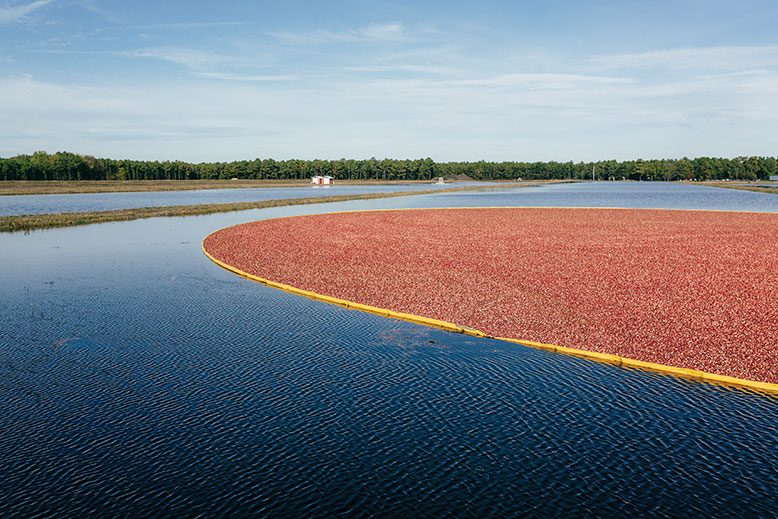
As the sun peeks over the horizon on this frosty fall morning, steam rises off vast stretches of shallow ponds. On closer inspection, blankets of round, red pellets can be seen floating on the surface of the ponds.
It’s near the end of the cranberry harvest, a time-honored tradition in South Jersey. On this Saturday in late October, more than 40 visitors have signed up to witness the labor-intensive process. Their tour will be conducted by Pine Barrens Native Fruits, a 350-acre cranberry farm in Browns Mills that is owned and operated by fifth-generation cranberry growers Joe Darlington and Brenda Conner.
Conner begins the tour by corralling the group into Heritage Hall, a shed turned classroom, where she shares the history and science of cranberry growing in New Jersey, the third largest producer of cranberries, behind Wisconsin and Massachusetts. Mixed into her tale of colorful characters and ideal pH levels for cranberries—they like acidic soil—are subtle messages about environmental protection.
“Cranberry growers are some of the fiercest protectors of water supply in the Pine Barrens,” says 52-year-old Conner, who grew up running a roadside fruit stand and trapping turtles. She proudly calls herself “a piney.”
It takes several years for a cranberry bog to mature, she explains, and up to 20 years for a cranberry farm to become profitable. “We’re very good with delayed gratification,” she notes.
Conner debunks the myth, perpetuated by ubiquitous Ocean Spray ads showing two wader-clad farmers standing in the bogs, that cranberries grow underwater. In fact, cranberries grow on vine runners in layered, sandy soil and remain nestled in a vine canopy until a cold snap in mid-September turns the berries crimson red. This is when farmers flood the fields to facilitate the wet harvest, a process that largely replaced dry picking in the late 1960s. Since cranberries have air pockets in their core, once they’re separated from their vines they float, making them easier to gather. Wet-harvested berries account for 97 percent of the yield and are used for processed foods, including juices. (The berries that produce white cranberry juice are picked just before they turn red.) The remaining 3 percent of the cranberry harvest is picked from pre-flooded fields; these berries are sold fresh in the produce section.
The best test of a fresh cranberry is to see if it will bounce, an experiment Conner invites 10-year-old Jackson Windsor-Starr from Hermosa Beach, California, to demonstrate by dropping a few berries on the floor of the shed. Ocean Spray uses a more sophisticated bounce-board separator to divide the good fruit from the spoiled.
Pine Barrens Native Fruits, like most of the cranberry growers in New Jersey, is a member of the Ocean Spray Cooperative. The farm sells about 98 percent of the 8 million pounds of cranberries it harvests each year to Ocean Spray. New Jersey’s cranberry industry once claimed more than 450 growers tending 14,000 acres of cranberry bogs. Today, it is down to fewer than 20 growers farming 2,500 acres, according to Conner.
“Cranberry farming is hard to get into and hard to get out of,” Conner says. “It’s difficult to get permits to create a bog. And once you’re in it, it’s hard to find buyers because most people don’t want to farm these days.”
Conner also describes the health benefits of the cranberry (high in vitamin C, fiber and antibacterial agents) and the various cranberry by-products (juice, sauce, and what’s quickly becoming the most popular product, sweetened dried cranberries, or Craisins, introduced by Ocean Spray in 1993).
Finally, the group boards two buses and heads for the bogs. Driving down a narrow dirt road, we are flanked by cranberry bogs as far as the eye can see. We stop to watch a harvester with a rotating water reel passing over the bog, pulling the berries free from their vine tendrils. The berries float to the surface. Five farmhands, who have been out since 7 am, shuffle through thigh-high, 50-degree water in their oversized, dun-colored waders, using long wooden planks to corral the newly freed cranberries. The berries are steered toward another machine that pumps them into the back of a dump truck. Once full, the truck takes its load of 5,000 pounds of berries to a preliminary cleaning station, where a high-pressure water-jet system washes the fruit and removes debris. The cleaned berries are passed on to an elevator conveyor and loaded onto a truck bound for the Ocean Spray receiving station in Chatsworth, where they’ll be further cleaned and processed.
The last stop of the three-hour tour is back at Heritage Hall, where Conner’s mother, Grace, offers her own reminiscences. She relates that her mother picked cranberries by hand in the 1920s for 10 cents a peck. As she talks, Grace shares samples of cranberry dishes Brenda has developed, including cranberry-orange relish, salsa, caramel-dipped cranberries and a cranberry-brie phyllo tart, all of which are included in a recipe booklet for visitors.
Touring the bogs was a bucket-list item for Susan Jones of Allentown, Pennsylvania, who was treated to the outing by her daughter, Amy Rozell of Somers Point. “We got to see every part of the operation, which was really fantastic,” said Jones. “They were so enthusiastic and engaged. I have so much respect for these people.”
Christopher Reinert had wanted to see a cranberry bog since he was a child. He and his girlfriend, Emily Schaible, traveled from Northeast Philadelphia for their visit. “It was so beautiful, and the people were so knowledgeable,” said Reinert. “I’d recommend it to anyone.”
Kathy and Pete Holmes of Mount Laurel said it was a privilege to visit the bogs. “I thought it was great that they opened up the family farm to tourists,” said Kathy. “It makes you want to support local farming.”
